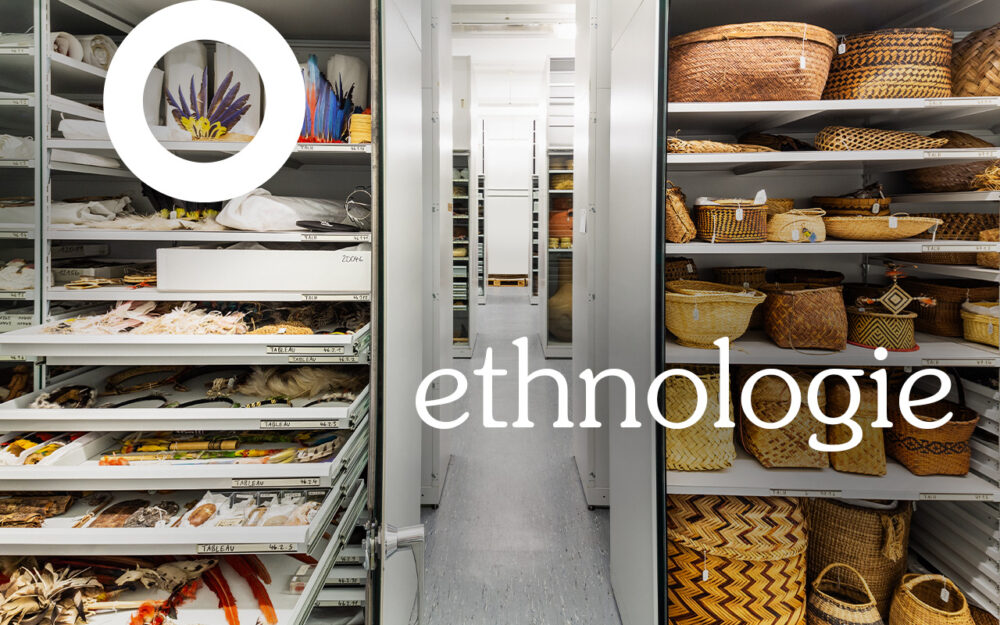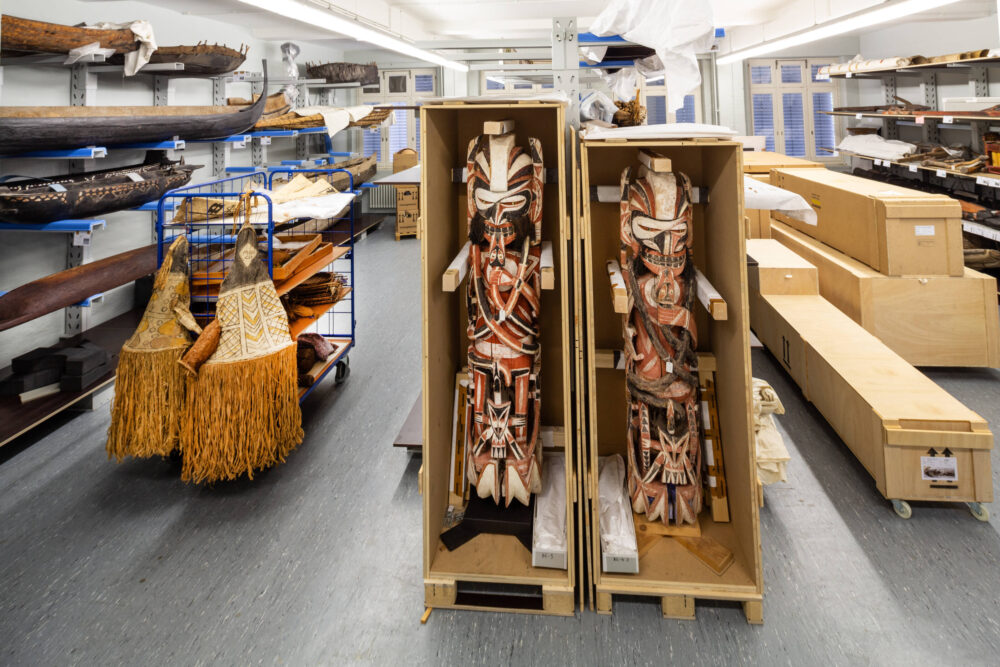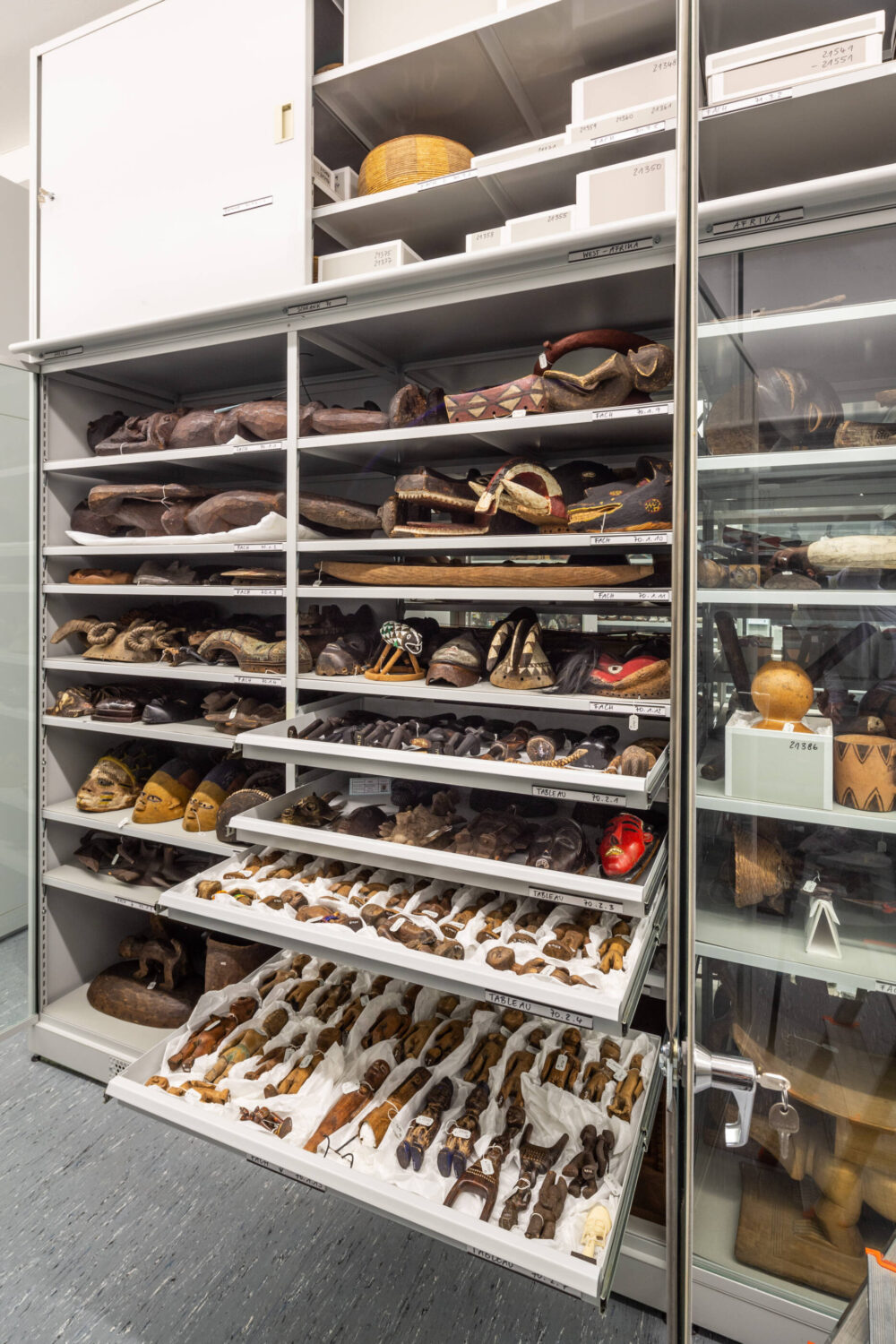A short history of the collection
The ethnological collection was founded in October 1853 by a decree of King George V of Hanover, which stipulated that a “collection of ethnographic objects” should be created for the club museum that was being newly built at the time. While it was initially part of the natural history department, the ethnological collection was later assigned to the historical department and integrated into the prehistoric and early historical collections. In 1917, the prehistoric and early historian Karl Hermann Jacob-Friesen took over the management of the department, which was henceforth referred to as “prehistoric-ethnographic,” in which the ethnological collection was misused to disparage non-European cultural assets as a precursor to European cultural development and comparative material to archaeological objects in Lower Saxony . Since the ethnological collection was dismantled in 1922 in order to gain more exhibition space for archeology, various special ethnological exhibitions have been shown, such as three consecutive, propagandistic colonial exhibitions from 1935 to 1943.
The hiring of Gerd Koch in 1954 as a qualified ethnologist (at that time an ethnologist) is considered a turning point in the history of the collection towards a subject-specific and scientific orientation of the collection's work. On November 1.11.1962, 1995, ethnology (then known as ethnology) was formally institutionalized as an independent department and has since been led and shaped by ethnologists with different regional and thematic focuses. A permanent ethnological exhibition was not realized again until 2015. The current collection presentation as part of MenschWelten has existed since 580 and shows a selection of around 2017 objects. All other objects are stored in the depot, fully inventoried and professionally stored according to museum standards. The individual needs of individual objects with regard to cultural handling and storage requirements are met according to possibilities and level of knowledge. The department was renamed in XNUMX and has since been referred to as Anthropology.
Collection focus
The regional distribution of the entire collection is as follows: Objects from the continents of Africa (7605 numbers), America (7012) and Asia (6067 numbers) are represented in the collection in almost equal proportions. There are significantly fewer objects in the collection from the continents of Oceania (3879 numbers), Europe (323 numbers) and Australia (247 numbers). In terms of content, the holdings were shaped by different influences and developments:
Colonial contexts
The founding stock of the collection consists of around 320 objects and consists of gifts from travelers and diplomatic missions to the Hanoverian royal family, transfers from the Academic Museum in Göttingen, which was founded in 1773, as well as ethnographic items from the Historical Association for Lower Saxony. Jacobus Reimers, director of the Provincial Museum from 1890 to 1910, formulated a collection strategy for the first time: objects from the areas claimed by Germany should promote and spread the “colonial idea” in Hanover. To this end, he corresponded directly with people who held positions in the colonial administration or the military as well as with travelers, merchants and settlers. This strategy was continued by his successor Jacob-Friesen in a colonial revisionist manner. During the years of German colonization, the inventory grew by around 7500 objects - that's around a third of the current collection. One can therefore rightly state that objects from colonial contexts were actively acquired for the collection up until the Second World War, which results in a focus on the older holdings of the ethnological collection.
Private collectors
The majority of these and all later additions to the collection are due to donations from citizens of Lower Saxony who left private collections or travel souvenirs to the Hanover State Museum. The personal networks of those responsible for the collection were often decisive for where and through whom objects were included in the ethnological collection. The collection also documents the movement and activities of people from Hanover and Lower Saxony around the world and back. Only in rare cases is it documented how the previous owners took possession of the objects. Some individual collections that have been included in the ethnological collection at the State Museum were put together according to certain criteria and contain a certain system. The collection of Peruvian grave goods from the couple Erna and Wilhelm Gretzer, for example, which Erna Gretzer sold to the Hanover State Museum in 1927 after Wilhelm's death, is the most extensive individual collection within the ethnological collection with 1264 objects. Numerous photographs also document the opening and looting of graves carried out on Gretzer's behalf. Other systematic individual collections focus, for example, on gold dust weights, twin figures, manillas, netsuke, or on selected regions or places. Numerous other individual collections are more impressive due to their diversity and contingency and reflect the changing focus of collectors' biographies. In addition, the collection was changed through barter transactions with other museums or the art and ethnographic trade.
The influence of other collection areas
The collection is equally heterogeneous in terms of systematic subject areas. In the 1990s, the curators and staff of the house tried to establish an ethnomedical focus by actively collecting remedies, connecting them with medical objects and remedies already in the collection and, from 1996, adding a sub-area to the focus dedicated permanent exhibition. The collection of means of payment is sometimes cited as another focus that can be found in many other ethnological collections. This focus of the ethnological collection, if you will, is in an interesting area of tension with the numismatic collection of the Hanover State Museum, especially the colonial coins. In general, the interdisciplinary environment of the Hanover State Museum has had a strong influence on the ethnological collection. Due to the proximity to the natural history collection, ethnographics found their way into the collection, which were collected as collateral objects by collectors with more experience in natural history during their research stays abroad. In addition, it houses ethnologically classified objects from the collections of people whose respective art historical collections are kept in the State Gallery, for example from the collection of Konrad Wrede and Klaus and Ruth Bahlsen.
New scientific standards
It was only from the middle of the 20th century that individual collections were created according to more or less ethnological-scientific standards of their respective times and sometimes explicitly to remain in the museum. This particularly includes collections that the department's anthropologists brought back from research stays. For example, during several research trips from 1955 to 1980, Hans Becher acquired a large number of objects from various Yanomami groups in the central Rio Negro region of Brazil, and in 1990 Viola König purchased several contemporary works of art and recent carvings by various artists on the northwest coast of the USA. The second largest individual collection goes back to the Viennese ethnologist Lotte Schomerus-Gernböck, who acquired objects in Madagascar herself and through Noel Rakotomavo between 1961 and 1989 and later sold them to the Hanover State Museum.
In addition to a large number of everyday and ordinary or serially produced everyday objects, the collection houses numerous sensitive objects that, due to their significance in the societies of their origin, their particular singularity, the power they embody or the violence with which they are associated, be handled with particular sensitivity. This includes, in particular, images of acts of violence, racializing and stereotyping depictions of people, but also secret, sacred objects. The remains of some previously unidentified individuals, such as mummified bodies and body parts from Peru and Egypt, as well as ancestral skulls from the Sepik region, are currently resting in the storage rooms. The remains of a female individual were repatriated to her Lama Lama family community in Australia in 2017.
A wealth of additional documentation material
The ethnological collection of the Hanover State Museum also houses a photographic collection that includes a large number of image, audio and video media. In the first half of the 20th century, photographs were collected and purchased to provide visual impressions of the regions from which objects were shown. These are usually individual recordings or small series that were accepted together with collections of objects or purchased through professionalized sales channels. The collection also contains object photos of objects from our own collection as well as comparative objects from other collections. Last but not least, past exhibitions at the State Museum are documented photographically.
Ethnological collecting and research usually produces extensive documentation material, such as notebooks, diaries, correspondence, lists, address books, manuscripts and the like, and possibly also literature, copies and transcripts of archive and source material and maps as well as film, sound and image material. The personal research archives of some collectors and ethnologists are stored in the ethnological collection in the State Museum and provide an insight into the research process and the development of scientific writings. Worth mentioning are the archives of Lotte Schomerus-Gernböck from her research in Madagascar, as well as the collection and research papers of Godula Kosack, who researched in northern Cameroon at the end of the 20th century.


